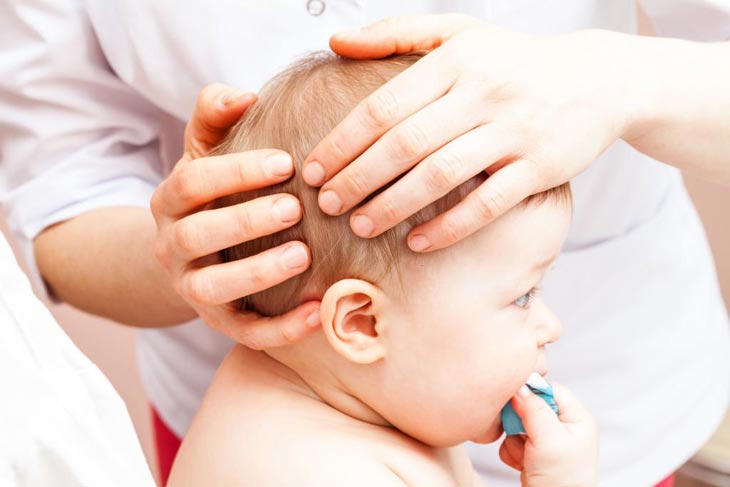Is it familiar with a dent in baby head after fall? Newborns are pretty fragile, especially their little heads.
One day, looking at a newborn’s head from the side, you suddenly spot a weird dent in the baby’s head, and a fear springs in your mind: What happens with my baby?
It’s a significant matter if something hits that soft spot intensively on the back of their head. There is a high risk of brain injury and concussion inside.
This article will tell you about the dangers of hitting your baby’s head and how to avoid it as much as possible.
What Is Dent In Baby Head After Fall?

“Baby hit forehead dent” is when a baby has a mark on their forehead after hitting it on something. Beyond, a dent looks like a not-perfect round on a baby’s head.
It’s usually called a “carpet sign,” as the mark that appears resembles a carpet from above. The mark is usually blue-black in color, indicating bleeding under the skin.
No matter how guaranteed you keep your baby, it’s probable that this little bundle of joy will fall and leave a mark on the head at some point.
Whether the kid does it on purpose or not, the status also comes up with slight ridges and bumps.
How you deal with those inevitable accidents is vital. Not every time the babies fall over with a bump requires a doctor visit; occasionally, it’s not too hard to resolve.
As long as your child doesn’t appear distressed by such accidents and stays joyful, don’t worry should your baby hit back of head.
What Happens If You Hit Your Head And Get A Dent?
Depending on the level and conditions, the kid may run some of the following risks: trauma, cancer, internal bleeding disorders, health issues like impaired balance, skull bones diseases, mild head injuries, head-shape deformity, memory loss, slurred speech.
Call 911 for the urgent first-aid assistant to impede the devastating impacts if the hefty hit leaves a severe status.
After the emergency medical is done, make a medical appointment at the healthcare center at once. The severity and type of injury will determine what the doctor should do to save the baby.
We understand you feel frightened seeing your baby showing a dent in forehead after hitting head. But staying calm is the wisest strategy you can count on to give your child prompt medical treatment.
Why Has My Baby Got A Dent In His Head? Other Factors

Besides falling, the roots of a dent in the babies’ heads may vary. They can result from medical conditions, injuries, or genetic matters. Take a closer look at these main reasons:
Tumors
Tumors can lead to bone deformity as well as dents in the baby’s head, but it’s relatively rare.
The journal Surgical Neurology International’s study shows that skull tumors account for only about 1-4% of bone tumors all together.
They often go with several symptoms, such as a painless mass, swelling, bone deformity, and bone pain.
Even benign forms (ossifying fibroma, fibrous dysplasia) also create the skull’s indentation.
Vitamin A Toxicity

Vitamin A plays a core part in boosting a strong immune system. It’s also crucial for heart and lungs’ health to operate stably. Still, too much index of Vitamin A causes adverse effects – developing toxicity.
This issue doesn’t often happen due to the food intake. The primary origin is from the overdose of Vitamin A supplements. This toxicity will soften the skull bones, resulting in an indentation.
Some sure signs of Vitamin A toxicity you can notice are a headache, dizziness, and nausea.
Gorham’s Disease
Gorham’s disease often results in abnormal blood vessels and bone loss. The disease may occur at any age yet is most common in children and teenagers.
Still, it just appears with a low rate overall. As aforementioned, bone loss causes an indentation in the baby’s skull, and the condition often impacts the pelvis and ribs.
Oftentimes, Gorham’s disease comes up with several symptoms, such as bone pain, swelling, decreased range of motion’s reduced capacity, and generalized weakness.
Congenital Skull Depression
The dent in a newborn’s head might come from a congenital skull depression, which is uncommon.
It often originates from trauma. For illustration, a suction device and forceps can bring the baby’s trauma and cause congenital skull depression.
Trauma mainly creates bone depression. It is also responsible for a severe brain injury with various symptoms: trouble breathing, feeding difficulties, and seizures.
Brain Surgery
Regarding the skull dent’s reasons, we can’t overlook brain surgery. Several certain types often end up with a dent.
For example, a craniectomy may mitigate pressure on the brain, creating swelling.
Surgeons recover the skull’s removed portion and create a small dent in head after injury. Furthermore, many side effects of brain tissues can emerge after the brain surgery.
Skull Fracture
A skull fracture can come from an impact or blow to the head, notably after direct force like a fall, a car accident, or physical assault.
The condition has four main types: depressed fracture, closed fracture, open fracture, and basal fracture, and open fracture.
Among them, a depressed skull fracture looks like one of the factors making a head dent right after the bone’s displacement toward the brain.
A traumatic brain injury often accompanies a skull fracture, resulting in impaired vision, headache, balance issues, nausea, dizziness, and confusion. Be careful with traumatic brain injury.
How Do I Know If My Baby Is Ok After A Fall?
Older-than-4-month children like moving, turning, and rolling instead of crawling, which often lead to a fall from the bed.
Don’t worry if your child quickly returns to his initial high spirit or cheers up, or there is no weird matter turning up. Minor incidents can’t make your child feel low.
In contrast, once your baby ignores you even if you call his name loudly or they seem irritated and constantly pinch you, along with these following expressions, go for emergency medical at once:
- Drowsiness
- Vomiting or spitting up
- Constantly whining or won’t wake up
- Bleeding
- A stomachache
- Faded reddish urine, showing possible bladder damage
- Cannot move legs or arms due to a joint, bone, or muscle injury in children
- Occurring head and neck pain and a dent
Once your child has these symptoms, ask a doctor for the effective pain medication, medical dose, and other treatments.
An appropriate bed is vital for the baby’s safety in the long run. In particular, the bed should not be over 120 cm high and 6cm wide (the distance between the bed railings).
Will Dent In Baby Head Go Away?
The remedy entirely relies on the severity of the situation. It takes roughly 6 months to let off the newborn’s head dent or skull abnormality.
Still, severe injuries will take a longer treatment time based on physical therapy, surgical treatments, and critical hospital-based intervention.
Rest, ice, and extra cuddles are the best physical therapy for such a case. Of note, you might as well consult the pediatrician.
Realizing some needed activity restrictions and meticulous medical care is irreplaceable.
Final Words
New parents – especially first-time parents – can anxious about whether their little ones will have some developmental delays after getting a dent.
Not to mention, any parent will freak out when they see a bump on the back of their baby’s head.
But before you imagine the worst, reading the sharing about dent to have the best medical care for your baby is needed.
That’s why we provided the ins and outs of a dent in baby head after fall in this short article.
